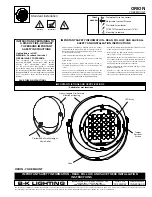
Page 3
For technical questions, please call 1-888-866-5797.
Item 63785
11.
Exposure to welding or cutting exhaust
fumes can increase the risk of developing
certain cancers, such as cancer of the
larynx and lung cancer.
Also, some diseases
that may be linked to exposure to welding
or plasma cutting exhaust fumes are:
•
Early onset of Parkinson’s Disease
•
Heart disease
•
Ulcers
•
Damage to the reproductive organs
•
Inflammation of the small intestine or stomach
•
Kidney damage
•
Respiratory diseases such as emphysema,
bronchitis, or pneumonia
Use natural or forced air ventilation and wear
a respirator approved by NIOSH to protect
against the fumes produced to reduce the
risk of developing the above illnesses.
12.
Do not use near degreasing or
painting operations.
13.
Keep head out of fumes.
Do not breathe exhaust fumes.
14.
Use enough ventilation, exhaust at arc, or
both, to keep fumes and gases from breathing
zone and general area.
If engineering controls
are not feasible, use an approved respirator.
15.
Work in a confined area only if it
is well-ventilated, or while wearing
an air-supplied respirator.
16.
Have a recognized specialist in
Industrial Hygiene or Environmental Services
check the operation and air quality
and make recommendations
for the specific welding situation.
Follow OSHA guidelines for
Permissible Exposure Limits (PEL’s) and
the American Conference of Governmental
Industrial Hygienists recommendations for
Threshold Limit Values (TLV’s) for fumes and gases.
17.
Wear ANSI-approved welding eye protection
featuring at least a number 10 shade lens rating.
18.
Wear leather leggings, fire resistant shoes
or boots during use.
Do not wear pants with
cuffs, shirts with open pockets, or any clothing
that can catch and hold molten metal or sparks.
19.
Keep clothing free of grease, oil,
solvents, or any flammable substances.
Wear dry, insulating gloves and protective clothing.
20.
Wear an approved head covering to protect
the head and neck.
Use aprons, cape, sleeves,
shoulder covers, and bibs designed and
approved for welding and cutting procedures.
21.
Wear an approved welding jacket or long sleeves
to protect forearms from radiation burns.
22.
When welding/cutting overhead or in confined
spaces, wear flame resistant ear plugs or
ear muffs to keep sparks out of ears.
23.
Turn off, disconnect power, and
discharge electrode to ground before
setting down torch/electrode holder and
before installing TIG torch to welder.
24.
Turn off, disconnect power, and
discharge electrode to ground before setting
down torch/electrode holder and before service.
25.
Do not touch energized electrical parts.
Wear dry, insulating gloves. Do not touch electrode
holder, electrode, welding torch, or welding wire with
bare hand. Do not wear wet or damaged gloves.
26.
Do not use near water or damp objects.
27.
People with pacemakers should consult their
physician(s) before use.
Electromagnetic fields
in close proximity to heart pacemaker could cause
pacemaker interference or pacemaker failure.
28.
Do not expose welders to rain or wet conditions.
Water entering a welder will increase
the risk of electric shock.
29.
Do not use outdoors.
30.
Insulate yourself from the workpiece and ground.
Use nonflammable, dry insulating material if possible,
or use dry rubber mats, dry wood or plywood, or
other dry insulating material large enough to cover
your full area of contact with the work or ground.
31.
Clear away or protect flammable objects.
Remove or make safe all combustible materials for a
radius of 35 feet (10 meters) around the work area.
Use a fire resistant material to cover or block all open
doorways, windows, cracks, and other openings.
32.
Keep ABC-type fire extinguisher near
work area and know how to use it.
33.
Maintain a safe working environment.
Keep the work area well lit.
Make sure there is adequate surrounding workspace.
Keep the work area free of obstructions,
grease, oil, trash, and other debris.
34.
Do not operate welders in atmospheres
containing dangerously reactive or
flammable liquids, gases, vapors, or dust.
Provide adequate ventilation in work areas
to prevent accumulation of such substances.
Welders create sparks which may ignite flammable
substances or make reactive fumes toxic.






























